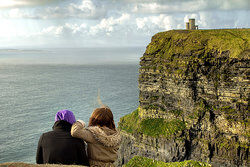
<font size="-1">The verdant glades that spread before them dazzled her with every shade of green.</font>
Have you ever read an excerpt from a book or poem and felt like you were standing in a flower-filled meadow or tip-toeing through a shadowy alleyway? Visual imagery appeals to the sense of sight and plays a large role in descriptive writing.
When used well, visual imagery can transport readers to a 15th-century castle in Italy or a bumpy road in Ireland, riddled with puddles and sheep. Being able to describe a scene is one of the most important elements of creative writing. Below, we’ll explore ten visual imagery examples to help you get your creative juices flowing.
Examples of Visual Imagery
Put on your sunglasses. We’re about to go on a sensory ride including bright bursts of sunlight, the verdant glades of Scotland, and delicate slips of moonlight through frost-covered glass.
- As she stepped out of the office building, she thought the bright, beaming sunlight would blind her. Immediately, she began rummaging through her purse for her Tom Ford shades.
- His phone signaled, immediately setting his teeth on edge. He looked at the cracked screen, saw her name, and slapped the phone back down on his desk.
- She sat at the desk, chin on hand, and carelessly flipped through the pages. When she got to chapter three, she sat up straight, and pulled off her glasses.
- The puppy sprawled across her couch, legs twitching feverishly, and she knew he must be dreaming of the squirrels he tries to capture every morning.
- He took her hand and led her to the edge of the cliff. The verdant glades that spread before them dazzled her with every shade of green.
- She accepted the bouquet. It was filled with her favorite flowers - white roses, purple irises, and soft sprays of baby’s breath. The flowers swayed in the breeze, almost as if they were dancing in her delight.
- He took the tattered leather-bound book from her. The cover was so faded, it was hard to make out the title. He was instructed to open it, but feared the anthology would crumble into dust.
- Together, they sat at the shoreline. The shimmering sun was sinking into the sea and, as it disappeared, she told him they’d never meet again.
- The monstrous German Shepherd lurched to its feet. Someone was at the door. As she reached for the handle, the dog burst through the slitted opening and lunged at the man.
- She couldn’t sleep. So, she got out of bed, trailed through the delicate slips of moonlight twinkling in the frost-covered glass, and turned on the kettle.
As we write, there are a multitude of ways to draw the reader into the story. We can catch their attention with an interesting bout of alliteration. Or, we can insert onomatopoeia to mimic the “splash” of water or the “kerplunk” of a log. These are two examples in a robust world of literary devices. For more on these, take a read through these Examples of Rhetorical Devices.
Why Do Writers Use It?
Famed romance writer, Nora Roberts, has a blog titled “Fall Into The Story.” Welcoming readers into a new world should be the goal of every creative writer. Readers enjoy being able to step out of their everyday lives and into new adventures. One of the most common ways to do this is through visual imagery.
With this tool, readers can use their imagination to sit before a peat fire in Ireland or zipline through the lush, green forest in Chile. They’ll know if the hot, scorching sun was burning their eyes or the hot, invisible sun was hiding behind the clouds.
Types of Imagery
All in all, there are five types of imagery in literature. They are:
- Visual Imagery - Without a doubt, this is the most common form of imagery. As we now know, it evokes vivid images of the characters and scenery.
- Olfactory Imagery - This form of imagery calls to our sense of smell. For example, “When he walked into her kitchen, he was assaulted by the scents of raspberry and caramel.”
- Gustatory Imagery - This form of imagery has to do with our taste buds. For example, “He bit into the crepe and thought the burst of raspberry would melt his tongue… until he tasted the warm drops of caramel.”
- Tactile Imagery - This deals with our sense of touch. For example, “The splash of boiling water bounced off the counter and singed her skin.”
- Auditory Imagery - Finally, this form of imagery calls to our sense of hearing. For example, “She found it difficult to fall asleep in the quiet cottage. Where were the blaring sirens and the sounds of midnight ramblers rolling through the streets?”
For a deeper dive, enjoy What Are the 5 Types of Imagery in Literature?
Envision a Visual World
Do you always have a story running through your head? When you go out to a restaurant, do you like to make up stories about the other people sitting around you? Is the old man dining alone mourning the loss of his wife? Is the couple staring at their cell phones on the brink of a divorce? Perhaps you have a future in storytelling.
One night, open up a blank Word doc and write a scene - just one scene. Try to paint a vivid image with your words, whether it’s a cluttered kitchen or an empty warehouse. And when you’re ready to create an entirely new world, take a look at Get Creative: How to Write a Short Story. We hope you’ll set the world on fire with your visual imagery and powerful attention to detail.